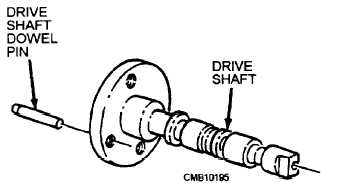When fuel pressure drops below injection pressure, the return spring closes the fuel valve.
NOTE For information on the removal and repair of the fuel injector nozzle, consult the manufacturer's service manual.
DISTRIBUTOR-TYPE FUEL SYSTEMS
The distributor-type fuel system is found on small- to medium-sized diesel engines. Its operation is similar to an ignition distributor found on gasoline engine. A rotating member, called a rotor, within the pump distributes fuel at high pressure to the individual injectors in engine firing-order sequence.
There are several manufacturers of distributor-type fuel injection systems. Operation of the fuel distribution is similar, in that a central rotating member forms the pumping and the distributing rotor is driven from the main drive shaft on which the governor is mounted.
The distributor-type fuel system that will be discussed is the DB2 Roosa Master diesel fuel-injection pump, manufactured by Stanadyne's Hartford Division.
Injection Pump
The Roosa Master fuel injection pump is described as an opposed plunger, inlet metering, distributor-type pump. Simplicity, the prime advantage of this design, contributes to greater ease of service, low maintenance cost, and greater dependability. Before describing the injection pump components and operation, let's familiarize ourselves with the model numbering system. For example, model number DB2833JN3000 breaks down like this:
D - Pump series
B - Rotor
2 - Generation
8 - Number of cylinders
33 - Abbreviation of plunger diameter; 33, 0.330 in.
JN - Accessory code that relates to special pump options
3000 - Specification number

Figure 5-12. - Drive shaft.
NOTE For information on the accessory code and the specification number for a particular pump, always refer to the manufacturer's service manual.
The main components of the DB2 fuel injection pump are the drive shaft, distributor rotor, transfer pump, pumping plungers, internal cam ring, hydraulic head, end plate, governor, and housing assembly with an integral advance mechanism. The rotating members that revolve on a common axis include the drive shaft, distributor rotor, and transfer pump.
DRIVE SHAFT (fig. 5-12) - The drive shaft is the driving member that rotates inside a pilot tube pressed into the housing. The rear of the shaft engages the front of the distributor rotor and turns the rotor shaft. Two lip type seals prevent the entrance of engine oil into the pump and retain fuel used for pump lubrication.
DISTRIBUTOR ROTOR (fig. 5-13) - The distributor rotor is the drive end of the rotor, containing

Figure 5-13. - Distributor rotor.
Continue Reading